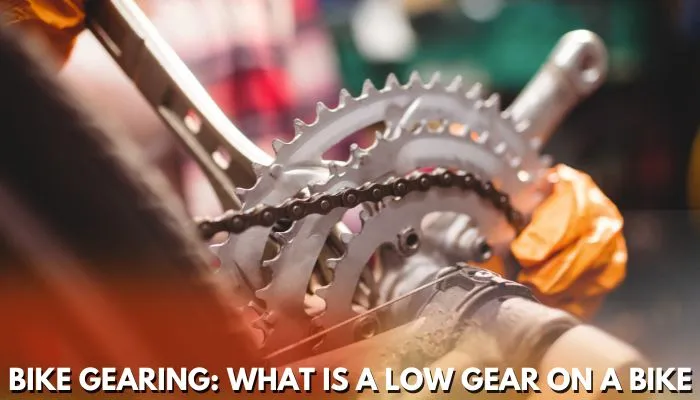Bike Gearing: What is a Low Gear on a Bike

Gears are a very beautiful creation. Gears allow us to get up hills and ride faster. We get a lot more enjoyment out of riding using gears. The energy you invest in the pedals is the energy transforming into a specific output at the wheel through gears. Your muscles can only exert a certain amount of effort, and there is a maximum tempo (the rate at which your pedals spin) at which you will be most effective.
Table of Contents
Short Answer:
You can move forward more effectively by shifting gears following the terrain and environmental factors to remain mostly inside that band.
Bikes may change gears in several ways, but the external drivetrain is the most popular.
Shifting gears on the bike is super confusing for those new to cycling. what is a low gear on a bike? What is the High gear on a bike? What gear should you use for climbing? How often should you shift? When is the best time for shifting gears on the bike? What about flats and descents? If these questions stop you from shifting gears, you’re probably not getting the most out of your bike.
What is a Low Gear on a Bike?
The low gear on a bike is the biggest cog on your cassette (rear gears) and the smallest chain ring in the front. You can bike uphill with the least detention in this position since it makes pedaling easy. Low gear is “downshifting” to enter this position.
What is High Gear on a Bike?

The High gear on a bike is the biggest chain ring in the front and the lowest cog on your cassette (rear gears). Do the heaviest pedaling in this posture, and you can accelerate while going downhill. High gear is “upshifting” to reach this posture.
Understanding of Low Gear
The understanding of “What is a low gear on a bike” is given below. Ultimately, the goal of the rider helps in determining the decision between low and high gear, their expertise, and the terrain they are riding on. Here are some points that help the rider adopt Low gear while cycling.
- Force
Low gear forces the rider to exert greater energy on the pedals, which may be exhausting over time. You must spin the pedals at a high cadence for little forward motion.
- Physical Component
The low gear consists of a smaller chainring and a bigger cog. As the rear cog is linked to the pedals, a larger cog necessitates more pedaling.
- Different Surfaces
Low gear is better for gripping the uneven and slippery ground. The slower speed helps the rider respond to terrain changes more rapidly. Low gear is best for uneven, excessively wet roads and muddy trains.
- Energy Efficient
The energy issue depends on the kind of terrain you are riding. If you’re climbing a steep incline, lower gears can suck your energy.
However, if everything is equal, the low gear is more effective for saving energy. Using Low gear, the cyclist can keep at regular speed without exerting as much power on the pedals.
- Uphill And Downhill
Low gear is beneficial for keeping a constant pace when climbing a hill. It allows the user to apply consistent effort to the pedals without fear of losing control of the bike.
- Control
The bike may seem sluggish and difficult to accelerate in low gear, but retaining control at modest speeds is simpler.
- Beginner Friendly
Riders who are still learning how to ride a bike might benefit from using low gear. It enables them to practice, handling the bike at slower speeds before attempting higher ratios.
- Additional Weight
Low gear is beneficial for cyclists carrying a big load, such as a caravan or a backpack. It lets them apply more energy to the pedals to compensate for the extra weight. When carrying a heavy load, this can make it easier to avoid losing control of the bike and maintain a consistent speed.
- Low Impact
Low gear permits cyclists who are getting better from an injury or have the limited physical ability to cycle at a slower speed without overexerting themselves.
This may be beneficial for cyclists who are just beginning to regain strength and endurance after an accident or who are physically unable to maintain a high cadence.
- Cadence
Low gear results in a quicker cadence, which might be more difficult and cause muscular fatigue. Furthermore, even if you pedal faster in low gear, you will travel much slower.
How to Use Gear on Bike?

You must identify the mechanism that shifts your gears to operate your bike’s gears properly.
The are different kinds of gear-changing systems. These may consist of the following:
- Integrated road gear shifter and brake lever.
- Twist-grip shifters.
- Trigger shifters.
- Downtube shifters
- Bar-end shifters.
You will use your hands to manipulate each of the above gear systems. The next stage is to learn when and how to utilize the bicycle gears.
Normally, you would want to put your bike in lower gear while ascending. You’ll be able to peddle more easily and climb the slope. On the other hand, it would be ideal to put your bike in high gear if you wanted to peddle quickly over a flat road.
Tips for shifting Gear between Low to High
You can easily shift gears between Low to High by following the tips below.
- Maintain consistent cadence.
It is critical to maintain a consistent cadence while biking. Cadence is the rate at which your paddles turn once. This is true irrespective of traveling up and down hills and terrain changes. You can maintain speed by getting into your natural cycling rhythm and be as efficient as possible with your techniques.
- Gradually go through the gears.
Begin by shifting into lower gears with your right hand to maintain a consistent cadence. Remember to utilize your right hand for navigating small changes in the terrain as if you see that your pedaling speed is dropping dramatically. Then use the front derailleur (with your left hand) to raise the gearing for the impending hard up a steep hill.
- Don’t grind those gears!
If you’re pedaling rapidly up the incline and slowing down, your front derailleur may fail to transfer gears. You could swap gears, hear a grinding sound, and suddenly halt in the middle of the slope.
To prevent grinding gears, increase your pedal stroke shortly before the change and ease up as you move. If you relax your hold on the chain, the derailleur will have an easier time moving your chain from the large ring to the smaller rings.
How Should a Beginner Ride a Bike with Gears?
To learn how to utilize bicycle gears, someone new needs to get familiar with the gears on their bicycle first. Practicing this ability is crucial as you can only change gears while pedaling.
Moreover, using bicycle gears should therefore be the next area of attention. An illustration of this is the practice of riding uphill in an easier gear to make climbing more pleasant. Try not to stress too much about riding in the right gear, especially if you’re a beginner! It will eventually come naturally to you.
How Many Gears Does a Bike Need?
How many gears you need on a bike depends on your cycling demand. These will include your riding location, level of experience, and physical fitness.
You’ll need more gears and lower gear ratios if you’re riding in mountainous terrain. You may get away with a single-speed bike or a fixie in flatter places. Moreover, Larger gear ratios could appeal more to stronger, experienced riders. These are best suited for navigating challenging terrain and challenging climbs.
People who commute by bicycle frequently might want to consider more low-maintenance options. 7-speed bikes are a common choice. A wide variety of gears are still available, and they gain from being easy and fast to maintain or repair while in use.
Overall, it depends on personal tastes and demands. I usually advise renting or purchasing several bike speed options for an experiment.
Does Bike’s Gear Number Matter?
The number of gears on a bike is important as it may affect what your bike is capable of. For instance, if you want to ride your bike a lot on the road in a mountainous place but only have a single gear, that would be problematic. This shows that “where you ride” and “the style of riding” you do matters.
Practice with Gears
The majority of geared bicycles have one to three chainrings in the front (the rings fastened to the pedal crank arm) and seven to twelve cogs in the back (the cassette fastened to the rear wheel).
Your pedaling effort gradually reduces when the chain moves from the smallest to the biggest rear cog. It is more obvious that when it is moved between the chainrings up front, pedaling is easy in the smaller chainring and harder in the larger one.
The easiest approach to learning how your bike gears feel when riding is to take your bike to a safe location away from traffic. such as an empty parking lot, and shift through all the front and rear ratios. In order to find their ideal cadence, cyclists spend most of their time changing back gear.
What Gear You Should Be In
While in high gear, consider pedaling up a hill. You must grind your way up the slope using extreme pedal pressure.
Instead, you can spin faster in a low gear because your force input at the pedals is lower. You use about the same amount of energy in each scenario. You may cycle twice as quickly by halving the force input necessary as the work is equal to the force times the distance.
However, the amount of power your legs can create (and your knees can take) has a limit. So there comes a moment when it’s advisable to change gears to lessen the energy. that use and raise your cadence. Knee injuries are crucial. Instead of grinding your way along, it is far better for your body to push very softly but more swiftly.
When Should You Shift the Gears?
Generally speaking, you need to change gears as soon as your speed changes or your terrain or level changes. A nice suggestion from my side is to switch gears before a climb. Since you won’t need to take your foot off the pedals to switch gears mid-climb, this can help you maintain your momentum.
Similarly, shifting gear when moving quickly at a higher cadence can make the transition seem quicker and smoother.
FAQs:
Is the bike’s low gear faster?
The low gear on a bike is faster, with a smaller chain ring in front and a bigger cog in the back. Lower gear helps you get going again when you stop or climb a steep hill.
Why is lower gear preferable for going uphill?
With an appropriate amount of momentum, approaching uphill situations made lower gear preferable for going uphill. You will be able to paddle uphill with the least amount of resistance in a lower gear.
Conclusion
Low gear on your bike is an essential gear selection that may simplify paddling and require less effort to ride uphill. You may have a pleasant ride using low gear. Your cycling performance increases by learning how to change into low gear and when to utilize it. Here we elaborate on “What is a low gear on a bike.”
Now anyone can climb uphill and on slippery roads utilizing the tips and understanding of Low gear on a bike. This article elaborates on the guidance regarding the shifting of gear.
